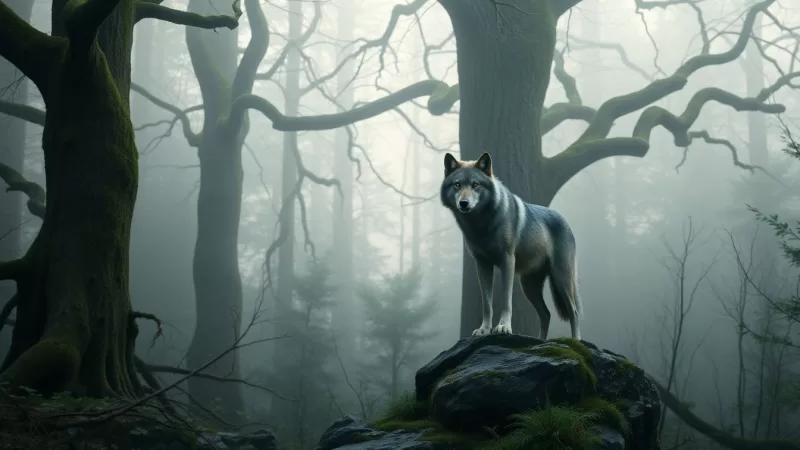Gray Wolf (Canis lupus): Extirpation from Massachusetts

Introduction
The gray wolf once roamed freely across Massachusetts, shaping the land and echoing in local stories. For centuries, these majestic animals were part of the state’s wilderness and culture. Today, the gray wolf is absent from Massachusetts, a loss that impacts ecosystems and biodiversity. While recent efforts aim to bring them back, understanding why they disappeared helps us plan better for the future. This article explores the history, causes, and effects of the gray wolf’s absence from Massachusetts and what it means for natural habitats.
Historical Range and Presence of Gray Wolves in Massachusetts
Indigenous and Colonial Periods
Gray wolves had a wide range in North America, including what is now Massachusetts. They played an important role in indigenous cultures, often seen as symbols of strength and survival. Native Americans respected wolves, sharing stories and sometimes offering food or protection. When European settlers arrived, wolves faced new threats. Their habitat shrank as towns grew and forests were cut down, making it harder for wolves to find food and safe den sites.
20th Century Decline and Extirpation
By the 1800s, wolves in Massachusetts had become rare. Hunting increased to protect livestock, and government programs promoted killing wolves. As farms expanded and forests disappeared, the animals lost vital habitats. The last confirmed wolf sighting in Massachusetts was in the early 1900s, marking the end of their natural presence in the state. Neighboring states like New York and New Hampshire still report small wolf populations today, but Massachusetts remains without wild wolves.
Reasons for Extirpation of Gray Wolves in Massachusetts
Human Activities and Hunting
Massachusetts had a long history of controlling predators. Bounty programs paid residents for each wolf killed, encouraging mass hunts. These policies aimed to protect livestock, but they wiped out whole wolf packs. Over time, laws changed, but the damage was done, and wolves disappeared from the area.
Habitat Destruction and Fragmentation
Urban sprawl took a toll on wildlife habitats. Forests were cleared for buildings, roads, and farms. This fragmented the landscape, making it difficult for wolves to find enough prey or safe places to breed. As their habitat shrank, wolves had no choice but to leave or die out.
Conflicts and Misunderstandings
Many people believed wolves attacked livestock or even humans, fueling fear and hatred. Media stories often exaggerated wolf threats, causing unnecessary panic. These misconceptions led to strict policies to eliminate wolves, which ultimately ended their presence in Massachusetts.
Ecological and Environmental Consequences of Gray Wolf Extirpation
Impact on Ecosystems
Wolves are top predators who control prey populations. Without wolves, deer numbers increased dramatically, overgrazing forests and harming plant life. This change created a cascade effect, reducing biodiversity and harming other species that relied on healthy forests. Without wolves, balance in local ecosystems was lost, causing long-term damage.
Consequences for Disease and Pest Control
Wolves help keep deer and other prey populations in check, reducing overpopulation. When deer run unchecked, they spread diseases and damage vegetation. Overabundant deer can also hurt farming and gardener interests. Losing wolves means losing a natural form of pest control—an important factor for ecosystem health.
Lessons from Regions Where Wolves Are Recovered
Places like Yellowstone National Park show what happens when wolves are reintroduced. Their return helped restore natural balances. Deer numbers dropped, tree growth improved, and other animals thrived again. These success stories reveal the benefits of wolf conservation and reintroduction efforts, showing what is possible.
Current Initiatives and Future Prospects for Wolf Conservation in Massachusetts
State and Federal Conservation Policies
Today, laws protect wolves and their habitats in many areas. Though Massachusetts doesn’t currently have wolf populations, some organizations push for corridors connecting neighboring states’ habitats. These could help wolves migrate and perhaps return someday.
Ongoing Research and Monitoring Efforts
Scientists study whether Massachusetts could support wolves again. They look at habitat quality, prey availability, and migration routes. Community groups also participate in citizen science projects, reporting wildlife sightings to help monitor potential zones for reintroduction.
Actionable Tips for Conservation Support
Anyone can help protect nature by preserving forests and green spaces. Supporting policies that promote coexistence strategies with wildlife makes a difference. Educating others about wolves’ ecological benefits can change negative perceptions and foster support for future recovery projects.
Conclusion
The loss of gray wolves from Massachusetts has left a void in local ecosystems. Their decline resulted from hunting, habitat loss, and misunderstandings. The ecological effects include overgrown deer populations, damaged forests, and reduced biodiversity. Learning from areas where wolves have returned teaches us that conservation can bring balance back. Promoting awareness and supporting habitat preservation could make reintroduction a real possibility in Massachusetts. Restoring wolves isn’t just about saving one species—it’s about healing the land and restoring natural harmony.

